
Yuan Works Co. Ltd. is a company founded by Yuan-Hsi and Yuan-Hao Chiang; who loved videogames since childhood. We started with a small and humble background in 1996: DiGi Pet, by Yuan-Hao. Over the years through effort, passion, and creativity, we have created an immense number of videogames, characters, and art.
Speaking of Yuan-Hao's first creation, Yuan Works is celebrating DiGi Pet's 10th Anniversary soon, and we have a special surprise!
Yuan-Hao's background
Yuan-Hao started to learn Visual Basic when he was still in grade school. Even without fully understanding what a variable was, he managed to program our first tool, Picex pixel picture viewer. After that came Picex II, and then Picex III; both with pixel art provided by Yuan-Hsi. Picex would eventually become the proprietary dot-art and animation tool for Yuan Works, since software for that purpose was not easy to find (nor use) at the time. Yuan-Hao himself also started to learn pixel artistry back then, and his combined efforts resulted in DiGi Pet , his first playable game, a silent grayscale virtual pet written in Visual Basic 3.0, back in 1996. Yuan-Hao has since become better versed in analog and digital (especially dot) art, and is an expert at fonts, but he works more regularly in the programming and game design fields. He has single handedly programmed many games and designed several as well. He also programmed our second animation tool for complex applications with full-fledged animation, the SceneAnime. Yuan-Hao has also worked in a great amount of illustrations and arts. He has a strong Visual Basic background, but now writes most game software in C and C++.
Yuan-Hsi's background
Yuan-Hsi started drawing dot art for fun back in 1995 on the first computers with Windows 95, on the (back then called) PaintBrush software. His first work imitated the Asian pixel art masters at the time with a limited size and palette. After getting familiar with the basics needed, he designed and did the graphics (and one song) for Yuan’s first RPG project, now known as DungeonCrawler – Dungeon Master Zero (though it was never titled). But it was not until TAMA RPG by Yuan that his definite role as artist for most of Yuan Work’s projects was defined. Yuan-Hsi sought to perfect many game artistry skills, and has always worked heavily on the concepts, stories, gameplay elements, graphics, music, and sounds of Yuan Works games. Over the last years Yuan-Hsi has written many stories, designed dozens of characters, animated hundreds of sprites, drawn thousands of tiles, composed more than a hundred songs, worked on over twenty fonts in several languages, and designed many games of all genres.
Cornerstones of Yuan Works
1998 and 1999: Joint efforts
A year and a half after DiGi Pet, the team ventures into a bigger scale RPG game. Since the game requires more intensive graphics and harder programming, Yuan-Hsi becomes the artist and Yuan-Hao the programer. After a prototype version in 1998, project Wind of Time is born. Since music was an important part of this project, Yuan-Hsi became the composer, writing more than 30 songs for this game alone!
But it is not until 1999, when Yuan Works starts their first serious artistic persuit, with Crystal Dream, EvilHeart, and Tien Shia: The Underheaven. All projects were very ambicious, but experience from both Yuan-Hsi and Yuan-Hao made these projects possible. They were true artistical experiments. Crystal Dream is the first long manga project by Yuan-Hsi, but it wasn't traditional anime like Wind of Time and helped define his personal styles. EvilHeart is Yuan-Hao's own manga, which spawned two versions and a tatical RPG which unfortunately never materialized. Although Tien Shia: The Underheaven has had so much work and thought, it hasn't been finished to this day.
|
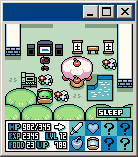
|
Late 2001: World of Sprites
After nearly one year of inactivity, Yuan-Hao decides to rejuvenate DiGi Pet, with a whole new design created by him. Programing the past games has paid off, and the new project advances with ease. Originally, Yuan-Hao was also going to do the art assets. However, Yuan-Hsi, who had stopped working on videogames for a while, decides to become the sprite artist; later took over the design created by Hao, and Pocket Angel is born. Before Pocket Angel, much of the art was done scanning, painting, and resizing every single image. Yuan-Hsi realizes that this is too much work, and decides to perfect his skills of creating sprite art directly; even for the more challenging things. Other than the character and concept design sketches, there is nothing on paper for this game. After several attempts, his spriting techniques become better, and considerably faster. Fantastic worldmaps and artwork are then created using sprite art, and Pocket Angel becomes our first game with complex graphics to rely exclusively on carefully placed pixels, with excellent results. |
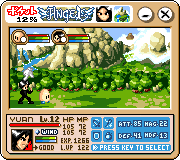 |
Magical RPG School & Dot
The team now returns to RPG game design, which is their favorite genre. Magical RPG School was a long-term project which surpassed the graphic quality of Pocket Angel. With the urgent need of a program to create animations easily, Yuan-Hao develops SceneAnime, which is used in the introduction sequence in Dot! |
 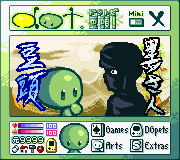 |
Vertical shooter Tenshin
In the year 2004 and 2005, the team creates their first vertical shooter, Tenshin - Shooting Star. Yuan Works had created many games, but not one game in which action played such an important role, with the exception of Shonin Ryuhi , and some of the Mini Series' games. It is also our first arcade game. This project demanded more time and effort in both art and programing, but was also a success. Tenshin - Shooting Star has a very innovative system, that adds a lot to the gameplay. It was in this project that we learned how to do complex engines and tight controls for technique and speed demanding games. |
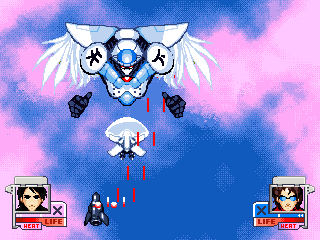 |
Wind and Water: Puzzle Battles arrives
In the year 2006, Yuan Works becomes interested in the Korean handheld GP2X. GPH, its creator, launches a 3-month worldwide contest for a licensing contract. Since the team has so little time, they decide to look for the help of two programers; with Yuan-Hao as lead programer, and Yuan-Hsi as the sole artist for graphics, sprites, music and sound effects. The goal is not only winning, but for the new game to have arcade-quality graphics and controls, and an extensive system like no puzzle game ever had. Sounds like an impossible challenge? Click here to visit the Wind and Water: Puzzle Battles homepage and find out about one of the deepest puzzle games ever created! |
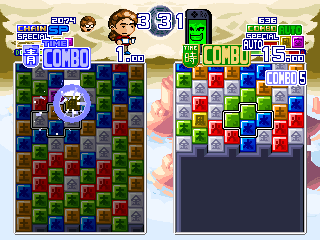 |
[ Back to Main ]
|
|

